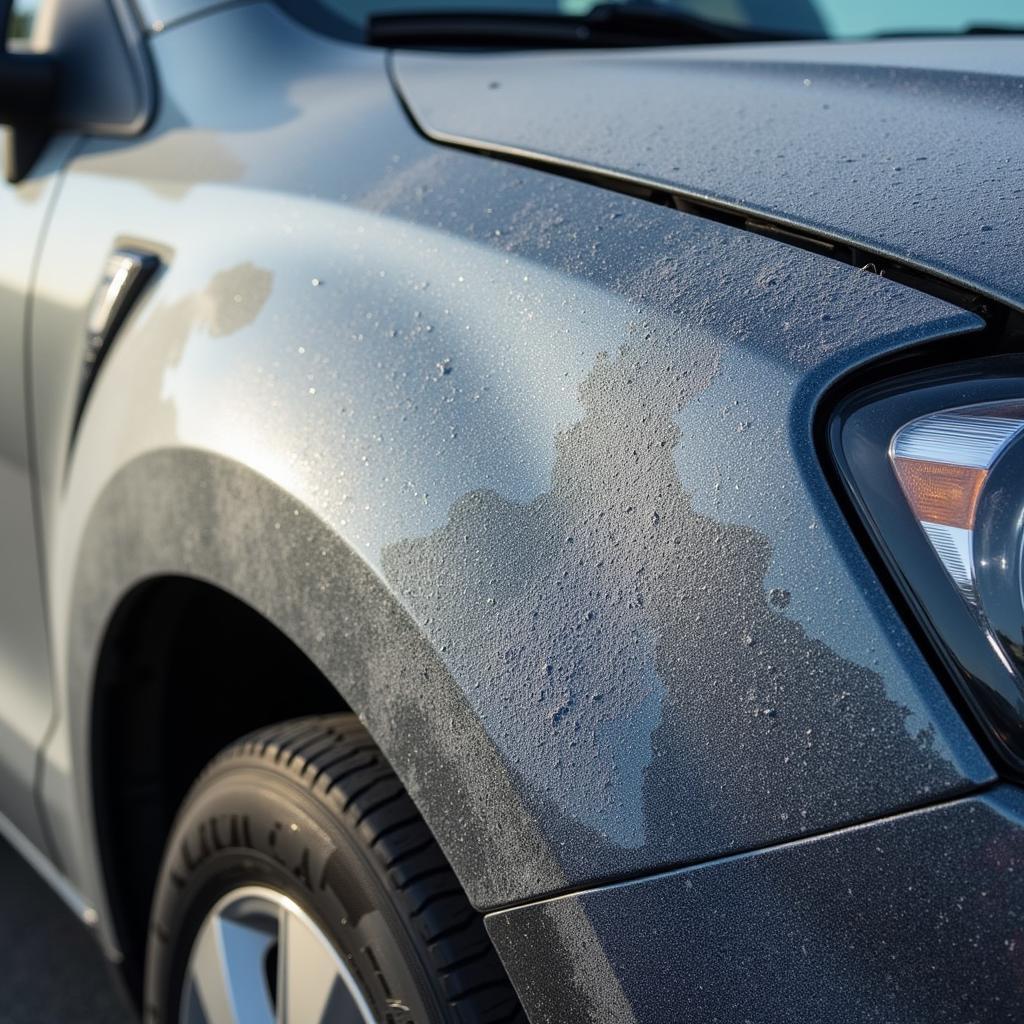Car oxidation, that dull, hazy film that makes your vehicle look aged and neglected, can absolutely be fixed. This guide provides a detailed overview of car oxidation, its causes, and most importantly, how you can tackle it yourself or find professional help.
 Close-up view of car oxidation damage
Close-up view of car oxidation damage
Oxidation occurs when the clear coat protecting your car’s paint breaks down due to prolonged exposure to the elements. UV rays from the sun, acid rain, airborne pollutants, and even bird droppings can contribute to this deterioration. As the clear coat weakens, the paint underneath is exposed to oxygen, leading to a chemical reaction that results in oxidation. This manifests as a faded, chalky, or rusty appearance.
Understanding Car Oxidation: Causes and Prevention
The primary culprit behind car oxidation is the sun’s ultraviolet (UV) radiation. Just like our skin, car paint is vulnerable to sun damage. Over time, UV rays break down the chemical bonds in the clear coat, making it more susceptible to oxidation. Environmental factors like acid rain and industrial fallout also accelerate the process. If you live near the coast, salt air can further exacerbate oxidation. Want to know who can fix those oxidized headlights? Check out who fixes headlights in cars.
Preventing Car Oxidation: Simple Steps for Long-Term Protection
The good news is that car oxidation is largely preventable. Regular washing and waxing are your first line of defense. A good wax creates a protective barrier against UV rays and other environmental contaminants. Parking your car in a garage or under a shaded area also significantly reduces sun exposure. Consider using a car cover for added protection, especially if you live in a harsh climate. These proactive measures will keep your car looking its best and preserve its resale value.
Fixing Car Oxidation: DIY and Professional Options
So, can car oxidation be fixed? Absolutely! Depending on the severity of the oxidation, you can choose between DIY methods and professional solutions. For light oxidation, a thorough wash, clay bar treatment, and polishing might be enough to restore the shine. More severe cases may require compounding, which involves using an abrasive compound to remove the oxidized layer of paint. If you’re dealing with rust spots, learn how to fix rust spots on a car.
DIY Car Oxidation Removal: A Step-by-Step Guide
- Wash and Dry: Thoroughly wash your car with a quality car wash soap and dry it completely.
- Clay Bar Treatment: Use a clay bar to remove embedded contaminants that washing can’t.
- Polish: Apply a polishing compound to restore the shine and remove minor oxidation.
- Wax: Apply a coat of wax to protect the paint and prevent future oxidation. For faded car paint, see how can i fix faded car paint.
Professional Car Oxidation Removal: When to Call the Experts
For severe oxidation or if you’re not comfortable with DIY methods, it’s best to consult a professional detailer. They have the expertise and specialized tools to restore heavily oxidized paint. They can also address issues like rust holes, as explained in how to fix rust hole on car roof. Professional detailing can significantly improve your car’s appearance and protect its value. If your car’s paint is sun-faded, explore the fix sun faded car paint kit.
“Prevention is key,” says renowned auto detailer, Michael Davies. “Regular washing, waxing, and proper storage can significantly reduce the risk of car oxidation.” Another expert, Sarah Chen, adds, “Even if oxidation occurs, it’s usually fixable. Don’t let it diminish your car’s appearance and value.”
Conclusion: Keeping Your Car Looking Its Best
Car oxidation is a common problem, but it’s one that can be effectively addressed. By understanding its causes and taking preventative measures, you can keep your car’s paint looking its best for years to come. Whether you choose DIY methods or professional detailing, addressing oxidation will enhance your car’s appearance and preserve its value. For further assistance or personalized advice, feel free to connect with us at AutoTipPro. Our team of experts is here to help!
Contact us at +1 (641) 206-8880 or visit our office at 500 N St Mary’s St, San Antonio, TX 78205, United States.






Leave a Reply